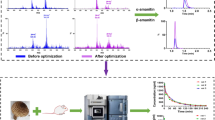Abstract
A number of reports are available in the literature that describe liquid chromatography-mass spectrometry (LC-MS) and LC-tandem mass spectrometry (LC-MS-MS) analysis of amanitins, very toxic mushroom toxins, in biological samples. However, the extractive pretreatment methods and LC separation column materials vary remarkably according to the different reports. This communication presents a very simple and suffi ciently sensitive method for LC-MS analysis of amanitins. A plasma sample was diluted with distilled water and buffer solution, and applied to a Discovery DSC 18 column (500 mg packing material), followed by washing with distilled water and elution with methanol. The extract, after evaporation and reconstitution in mobile phase solution, was subjected to LC-MS analysis with a conventional octadecyl LC separation column. The selected ion monitoring of α-amanitin and β-amanitin at m/z 919–921 and m/z 920–922, respectively, gave symmetrical peaks and good separation of both amanitin peaks. Using an external calibration method, linearity, detection limits, recovery rates, and precision were tested; they were all satisfactory. To our knowledge, the present method gives the simplest LC-MS analysis for amanitins among those so far reported. We recommend the method for use in actual forensic and clinical toxicological analysis of amanitins in biological samples.
Similar content being viewed by others
References
Wieland T, Faulstich H (1987) Amatoxins, phallotoxins, and antamanide: the biologically active components of poisonous Amanita mushrooms. Crit Rev Biochem 5:185–260
Wieland T (1987) 50 Years of phalloidine: its discovery, characterization and current and future applications in cell research. Naturwissenschaften 74:367–373
Dorizzi R, Michelot D, Tagliaro F, Ghielmi S (1992) Methods for chromatographic determination of amanitins and related toxins in biological samples. J Chromatogr 580:279–291
McPartland JM, Vilgalys RJ, Cubeta MA (1997) Mushroom poisoning. Am Fam Physician 55:1797–1800
Köppel C (1993) Clinical symptomatology and management of mushroom poisoning. Toxicon 31:1513–1540
Enjalbert F, Rapior S, Nouguier-Soulé J, Guillon S, Amouroux N, Cabot C (2002) Treatment of amatoxin poisoning: 20-year retrospective analysis. J Toxicol Clin Toxicol 40:715–757
Faulstich H, Zobeley S, Trischmann H (1982) A rapid radioimmunoassay, using a nylon support, for amatoxins from Amanita mushrooms. Toxicon 20:913–924
Andres RY, Frei W, Gautschi K, Vonderschmitt DJ (1986) Radioimmunoassay for amatoxins by use of a rapid, 125I-tracerbased system. Clin Chem 32:1751–1755
Andres RY, Frei W (1987) [125I]Amatoxin and anti-amatoxin for radioimmunoassay prepared by a novel approach: chemical and structural considerations. Toxicon 25:915–922
Jehl F, Gallion C, Birckel P, Jaeger A, Flesch F, Minck R (1985) Determination of α-amanitin and β-amanitin in human biological fluids by high-performance liquid chromatography. Anal Biochem 149:35–42
Enjalbert F, Gallion C, Jehl F, Monteil M, Faulstich H (1992) Simultaneous assay for amatoxins and phallotoxins in Amanita phalloides Fr. by high-performance liquid chromatography. J Chromatogr 598:227–236
Tagliaro F, Chiminazzo S, Maschio S, Alberton F, Marigo M (1987) Improved high performance liquid chromatographic determination of amanitins with electrochemical detection. Chromatographia 24:482–486
Tagliaro F, Schiavon G, Bontempelli G, Carli G, Marigo M (1991) Improved high-performance liquid chromatographic determination with amperometric detection of alpha-amanitin in human plasma based on its voltammetric study. J Chromatogr 563:299–311
Maurer HH, Kraemer T, Ledvinka O, Schmitt CJ, Weber AA (1997) Gas chromatography-mass spectrometry (GC-MS) and liquid chromatography-mass spectrometry (LC-MS) in toxicological analysis. Studies on the detection of clobenzorex and its metabolites within a systematic toxicological analysis procedure by GC-MS and by immunoassay and studies on the detection of α- and β-amanitin in urine by atmospheric pressure ionization electrospray LC-MS. J Chromatogr B 689:81–89
Maurer HH, Schmitt CJ, Weber AA, Kraemer T (2000) Validated electrospray liquid chromatographic-mass spectrometric assay for the determination of the mushroom toxins α- and β-amanitin in urine after immunoaffinity extraction. J Chromatogr B 748:125–135
Chung W-C, Tso S-C, Sze S-T (2007) Separation of polar mushroom toxins by mixed-mode hydrophilic and ionic interaction liquid chromatography-electrospray ionization-mass spectrometry. J Chromatogr Sci 45:104–111
Filigenzi MS, Poppenga RH, Tiwary AK, Puschner B (2007) Determination of α-amanitin in serum and liver by multistage linear ion trap mass spectrometry. J Agric Food Chem 55:2784–2790
Ahmed WHA, Gommori K, Suzuki M, Watanabe K, Suzuki O (2010) Simultaneous analysis of α-amanitin, β-amanitin, and phalloidin in toxic mushrooms by liquid chromatography coupled to time-of-flight mass spectrometry. Forensic Toxicol (in press). DOI 10.1007/s11419-009-0089-7
Brüggemann O, Meder M, Freitag R (1996) Analysis of amatoxins α-amanitin and β-amanitin in toadstool extracts and body fluids by capillary zone electrophoresis with photodiode array detection. J Chromatogr A 744:167–176
Robinson-Fuentes VA, Jaimes-Sánchez JL, Garcia-Aguilar L, Gomez-Peralta M, Vazquez-Garciduenas MS, Vazquez-Marrfo G (2008) Determination of α- and β-amanitin in clinical urine samples by capillary zone electrophoresis. J Pharm Biomed Anal 47:913–917
Jager A, Jehl F, Flesch F, Sauder P, Kopferschmitt J (1993) Kinetics of amatoxins in human poisoning: Therapeutic implications. Clin Toxicol 31:63–80
Author information
Authors and Affiliations
Corresponding author
Rights and permissions
About this article
Cite this article
Tanahashi, M., Kaneko, R., Hirata, Y. et al. Simple analysis of α-amanitin and β-amanitin in human plasma by liquid chromatography-mass spectrometry. Forensic Toxicol 28, 110–114 (2010). https://doi.org/10.1007/s11419-010-0098-6
Received:
Accepted:
Published:
Issue Date:
DOI: https://doi.org/10.1007/s11419-010-0098-6




